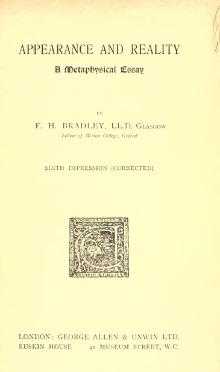Appearance and Reality
 | |
| Author | Francis Herbert Bradley |
|---|---|
| Country | United Kingdom |
| Language | English |
| Genre | Philosophy |
| Published | 1893 |
| Media type | |
Appearance and Reality is an 1893 book by the English philosopher Francis Herbert Bradley, the main statement of his metaphysics.[1]
Summary
Appearance and Reality comprises two volumes, one on "Appearance" and the other on "Reality".[1]
Bradley argues in "Appearance" that most ordinary things (objects and their qualities, time and space, causation, the self, and even things-in-themselves) are only appearances, while in "Reality" he attempts to provide a more accurate description of the reality they misrepresent to us. This reality is the Absolute, a single cosmic experience of which people are components. Bradley, by calling something an appearance, means that the concept of it provides a pragmatically useful way of thinking about some aspect of the world. Being incoherent, such concepts cannot provide a finally satisfactory grasp of reality. For example, something in the Absolute corresponds to time, but it is so unlike time as ordinarily conceived that time as normally understood must be considered an illusion. However, reality (as predicate) is a matter of degree: concepts are true or false of reality (as thing) in different degrees. The concept of the Absolute is more adequate than that of time, but both are only ways of attempting to understand what the intellect cannot fully comprehend. Bradley tries to establish these conclusions by arguing that reality must have a unitary togetherness that cannot be captured by the ordinary conception of many distinct things in relation, and that all concrete reality must somehow be psychical in nature. Reality is one vast eternal self-experiencing many-in-one.[1]
Scholarly reception
Appearance and Reality is regarded as Bradley's most important book.[2]
See also
References
Footnotes
- ↑ 1.0 1.1 1.2 Sprigge 2005. pp. 105.
- ↑ Clark 1975. p. 45.
Bibliography
- Books